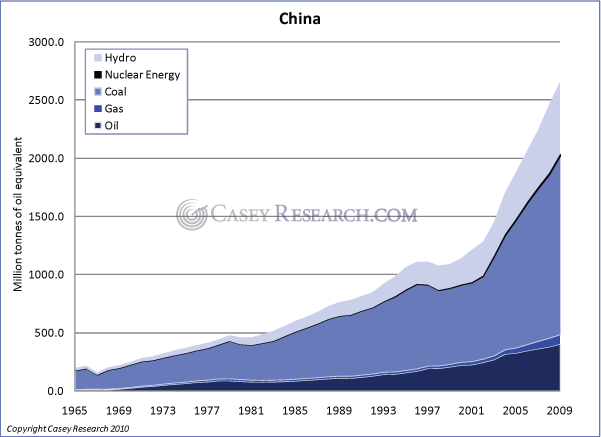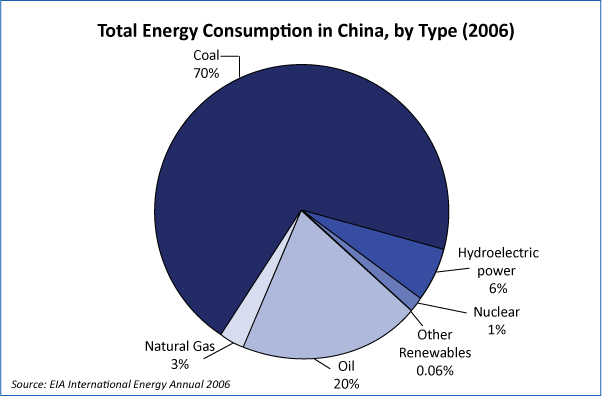China Is Winning the Energy Race
Commodities / Energy Resources Aug 05, 2010 - 12:15 PM GMTBy: Marin_Katusa
 Marin Katusa, Casey’s Energy Opportunities writes: Stop the presses. The United States is no longer the world’s biggest consumer of energy.
Marin Katusa, Casey’s Energy Opportunities writes: Stop the presses. The United States is no longer the world’s biggest consumer of energy.
After topping the energy consumption charts for more than a century, the U.S. has been left behind as China leapfrogged past. According to the International Energy Association’s (IEA) latest report, China burned its way through 2,252 million tonnes of oil equivalent last year – about 4% more than the U.S.
(The oil-equivalent measure is a bundle of all forms of energy consumed, including crude, coal, nuclear, natural gas, and renewable resources.)
That’s an astonishing turnaround, according to IEA chief economist Fatih Birol, who noted that as recently as 2000, the U.S. consumed twice as much energy as China.
Energy Consumption Trends of China and the United States 1965 – 2009
.gif)

Source: BP Statistical Review of World Energy, 2010
It’s no longer 1973, when President Nixon could declare that our status as top energy consumer was “good. That means we are the richest, strongest people in the world.” Today, bragging about winning the energy-eating competition doesn’t gain you any brownie points. Which is probably why Chinese authorities were quick to reject the IEA data as “unreliable,” choosing instead to focus on their intention to sink about 5 trillion RMB (about US$750 billion) into renewable energy projects.
Despite the denials, a new age in the history of energy has begun, and the implications are enormous. China may not want to accept the honors, but the reality is that it’s now the most important player on energy’s demand side.
According to the IEA report, China will be investing more than $4 trillion over the next 20 years to ensure there are no power or fuel shortages, and that there is enough energy to keep feeding its economy. Thus the ever-increasing number of ships steaming out from Canadian and Australian ports: all are bound for Beijing, all loaded with precious energy supplies.
Whether it’s coal, gas, uranium, or oil, China’s import numbers are only heading one way – up. Here’s a brief overview.
Coal:
The wealth of Western nations was built on the back of coal, and China plans to be no different.
King Coal, cheap and plentiful in China, accounts for 70% of all energy consumed. Most of that goes to meet the burgeoning demand for power, and with US$30 billion just invested into improving the national electrical grid, we’re not going to see coal taking a backseat anytime soon.
China also needs metallurgical (coking) coal for producing steel – the backbone of an economy. As the construction boom continues, corporations will be crying out for it. But with no higher-grade reserves of its own, China is buying up whatever is in the market, sending coal prices skywards.

Oil:
Beijing continues its relentless courting of oil-rich countries across the globe. Its national oil companies (NOCs) offer debt forgiveness, development packages, infrastructure improvements, and, yes, bribes, in exchange for secure oil contracts, especially in Africa. The net overseas production from the three Chinese NOCs for 2010 will be a record-breaking 1 million barrels a day... that’s enough to fuel all of Australia!
Not content with just acquiring oil assets outright, Chinese NOCs are also tying up partnerships with other oil companies. In fact, the three Chinese NOCs accounted for nearly 20% of all global deal values in the first quarter of 2010.
Nor has China ignored North America. It’s heavily invested in the oil sands of northern Canada. This huge reserve is likely to become the most important source of U.S. oil, and China is making sure its finger is very firmly in the pie.
The U.S. still remains the number one consumer of crude. But over the past three years, China has accounted for at least a third of world demand growth in crude. And with a projected 45% increase in demand in the next five years, Chinese NOCs won’t be hitting the brakes anytime soon.
Gas:
China is throwing itself onto the clean and green bandwagon as well. And the cleaner-burning alternative to oil is its cousin, liquefied natural gas (LNG).
Expectations are for a hike of almost 50% in Chinese demand for LNG by 2020. This year alone, China is expected to boost its LNG imports by about 65%, from 5.5 million tonnes in 2009.
No surprise that China is wedging its foot very firmly into the vast gas reserves of Kazakhstan, Uzbekistan, and Tajikistan. A 1,100-mile-long pipeline has just been completed to link Chinese factories and power plants to Central Asia.
Unconventional gas deposits – like shale gas – will also have a role to play. The country’s shale gas reserves are estimated to be about 26 trillion cubic meters.
As China wakes up to the potential of this energy source, it’s also waking up to the fact that the technology to unlock it is in North America. So planes full of well-heeled Chinese investors are heading on over to woo North American producers.
If you’re a small-capitalization firm, with the potential to lower costs and risks, improve project returns and tap opportunities that are otherwise beyond reach, you’re in demand.
Uranium:
Nuclear power is coming to China in a big way. The country is set to purchase up to 5,000 metric tonnes of uranium this year – more than twice what it needs.
But consider that by the year 2020, China will have at least 60 nuclear reactors up and humming across the country, throwing off 85 gigawatts of output and demanding 20,000 tonnes of fuel per year. That’s nearly 40% of the 50,572 tonnes mined globally in 2009.
Now the hoarding makes more sense.
The result: After a three-year lull, uranium prices are spiking up. Analysts at RBC Capital Markets have predicted a 32% spike in prices for next year – for a uranium company, this is Christmas come early. And while the bull market of 2006 saw at least 27 new uranium mines opening up across the world, it’s not going to be enough. Yellowcake is back, and it’ll be glowing red this time around.
China might not wish to be called the world’s biggest energy consumer, but it’s a fact, and its edge will continue to grow. The process of explosive economic development is like feeding teenagers – they’re never full. And while China continues on this tear to eat up the world’s coal, oil, uranium, and gas, there are some great opportunities unfolding.
Which producers are favorites to supply China?
Which companies are most attractive to Chinese investors, and to the NOCs?
When will uranium prices jump by 200% again?
We’ve put a lot of effort into charting China’s moves on the energy game board, and things are getting exciting. If you’re an investor, this is the perfect time to boost your portfolio with some carefully chosen stocks that will make the trend your friend. Try Casey’s Energy Opportunities for only $39 a year – and with our 3-month money-back guarantee. Read more here.
© 2010 Copyright Casey Research - All Rights Reserved
Disclaimer: The above is a matter of opinion provided for general information purposes only and is not intended as investment advice. Information and analysis above are derived from sources and utilising methods believed to be reliable, but we cannot accept responsibility for any losses you may incur as a result of this analysis. Individuals should consult with their personal financial advisors.
© 2005-2022 http://www.MarketOracle.co.uk - The Market Oracle is a FREE Daily Financial Markets Analysis & Forecasting online publication.



